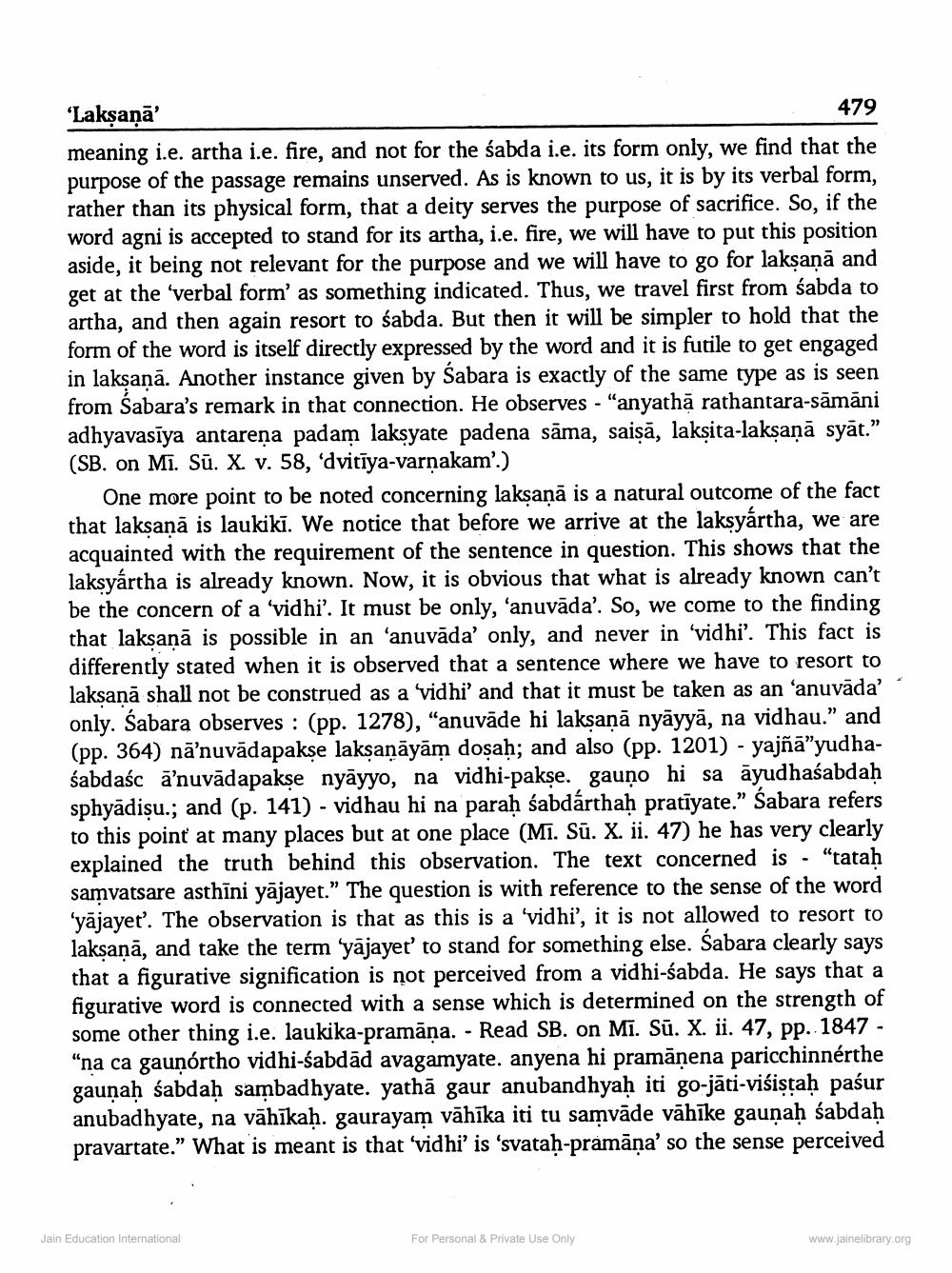________________
‘Lakşaņā
479 meaning i.e. artha i.e. fire, and not for the sabda i.e. its form only, we find that the purpose of the passage remains unserved. As is known to us, it is by its verbal form, rather than its physical form, that a deity serves the purpose of sacrifice. So, if the word agni is accepted to stand for its artha, i.e. fire, we will have to put this position aside, it being not relevant for the purpose and we will have to go for laksaņā and get at the 'verbal form' as something indicated. Thus, we travel first from sabda to artha, and then again resort to śabda. But then it will be simpler to hold that the form of the word is itself directly expressed by the word and it is futile to get engaged in laksanā. Another instance given by Sabara is exactly of the same type as is seen from Sabara's remark in that connection. He observes - "anyatha rathantara-sāmāni adhyavasiya antarena padam laksyate padena sama, saisā, laksita-laksanā syāt.” (SB. on Mi. Sū. X. v. 58, 'dvitīya-varnakam'.)
One more point to be noted concerning laksaņā is a natural outcome of the fact that laksanā is laukikī. We notice that before we arrive at the laksyártha, we are acquainted with the requirement of the sentence in question. This shows that the laksyártha is already known. Now, it is obvious that what is already known can't be the concern of a 'vidhi'. It must be only, 'anuvāda'. So, we come to the finding that laksanā is possible in an 'anuvāda' only, and never in 'vidhi'. This fact is differently stated when it is observed that a sentence where we have to resort to laksanā shall not be construed as a vidhi' and that it must be taken as an 'anuvāda' only. Sabara observes : (pp. 1278), "anuvāde hi laksanā nyāyyā, na vidhau.” and (pp. 364) nā’nuvādapakse laksanāyām dosah; and also (pp. 1201) - yajñā"yudhasabdaśc a'nuvādapakse nyāyyo, na vidhi-pakse. gauno hi sa āyudhaśabdah sphyādiņu.; and (p. 141) - vidhau hi na paraḥ śabdárthaḥ pratīyate.” Sabara refers to this point at many places but at one place (Mi. Sū. X. ii. 47) he has very clearly explained the truth behind this observation. The text concerned is - "tatah samvatsare asthini yajayet.” The question is with reference to the sense of the word 'yājayet'. The observation is that as this is a 'vidhi', it is not allowed to resort to laksanā, and take the term 'yājayet' to stand for something else. Sabara clearly says that a figurative signification is not perceived from a vidhi-sabda. He says that a figurative word is connected with a sense which is determined on the strength of some other thing i.e. laukika-pramāņa. - Read SB. on Mī. Sū. X. ii. 47, pp. 1847 - "na ca gaunortho vidhi-sabdād avagamyate. anyena hi pramānena paricchinnérthe gauņaḥ śabdah sambadhyate. yathā gaur anubandhyaḥ iti go-jāti-viśistaḥ pasur anubadhyate, na vāhīkaḥ. gaurayam vāhīka iti tu samvāde vāhīke gaunaḥ śabdaḥ pravartate.” What is meant is that 'vidhi' is 'svatah-pramāņa' so the sense perceived
Jain Education International
For Personal & Private Use Only
www.jainelibrary.org




